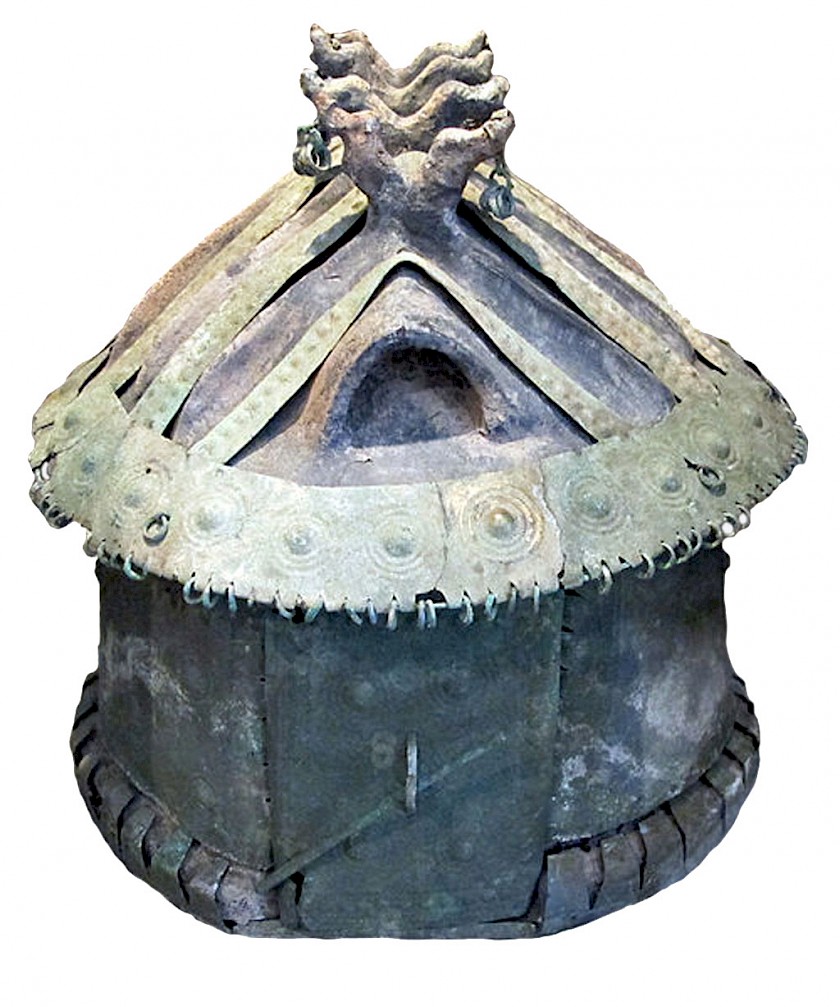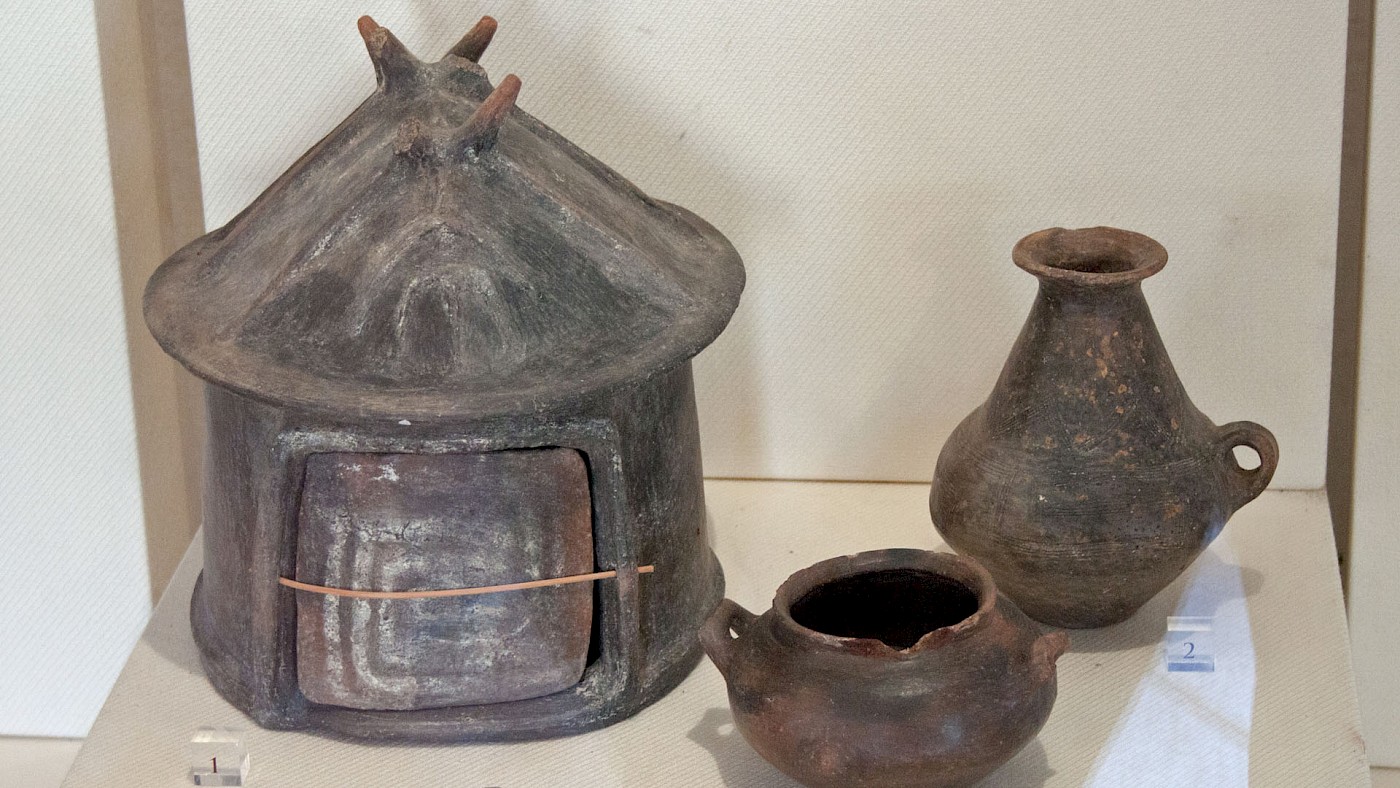Burial practices vary widely throughout world history. Many seem quite bizarre to outsiders, even more so when looked back upon centuries, or millennia, later. One of the most important elements of these rites are the vessels in which the deceased was placed.
From the end of the Bronze Age throughout the Early Iron Age, the peoples of Central Italy used an eye-catching type of urn in which their cremated remains were interred: the hut urn. They were used from about 1000 BC until 700 BC. (In varying chronological terminology, this means in Etruria: Final Bronze Age 3, Early Iron Age 1 Early, Early Iron Age 1 Late, Early Iron Age 2 Early/Late, Early Iron Age 2 Final (or in the old chronological terms Final Bronze Age, Villanovan 1, Villanovan 2, and the early years of the Early Orientalising); in Latium: Latial Periods I, IIA, IIB, IIIA, IIIB. The chronology of Central Italian cultures is an ongoing discussion.) As the name would suggest, these urns were shaped like huts. These have been of interest to archaeologists and classicists for a very long time, allowing Giovanni de Rossi to state already in 1879 that they were “oggimai notissime” (very well known; G.B. de Rossi, Piante iconografiche e prospettiche di Roma anteriori al secolo XVI (1879), p. 3).
Hut urns of Central Italy
Hut urns were first used in the region we call Latium Vetus; the form was then readily adopted in Etruria. (I use these geographical terms for convenience, although it should be noted that some prehistorians prefer to avoid them as they carry with them ideas, both ancient and modern, about certain boundaries which are not necessarily applicable to the Early Iron Age. For reference, as used here, “Etruria” and “Latium Vetus” roughly cover the modern Italian regions of Lazio, Toscana, and Umbria.) An old theory proposed that the form was inspired by Mycenaean contacts with Central Italy, but this is improbable (included in the discussions of various scholars, such as H. Hencken, Tarquinia and Etruscan Origins (1968)).
Most modern commentators maintain that they reflected structures that were used in life. The remains of many huts have been found throughout Latium Vetus and Etruria dating to this era which were similar in shape to the urns. Although less common than the biconical urn, the ubiquitous burial vessel of Iron Age Etruria, archaeologists have recovered many of the hut urns, with Bartoloni and her colleagues being able to include almost two-hundred examples in their catalogue (G. Bartoloni et al., Le urne a capanna rinvenute in Italia (1987). The ratio of hut urns to bi-conical urns is around 1 to 100). Since this was published, a number of further examples have been discovered, at sites such as Osteria dell’Osa, Villa Bruschi Falgari, and Montetosto.
The urns are typically ovular, or curvilinear, in shape, although some are more square. Usually there is a single entry to the structure being depicted. The roofs are peaked and almost always show exposed timbers. On the top ridge line we often find either the ends of timbers or akroteria, essentially decorative elements.

A wooden chair from Verucchio shows a hut upon which are perched humans or birds. (The so-called throne from Verucchio can be found in P. von Eles (ed.), Guerriero e sacerdote. Autorità e comunità nell’età del ferro a Verucchio. La tomba del trono (2002).) These could represent gods, ancestral spirits, or other supernatural entities who were meant to protect the hut in life and the deceased buried within a miniaturised version in death. It is unclear if all huts would have been crowned by these figures, and it is possible that those belonging to persons of a lower social standing may not have been given such protection.
Urns and social structure
A difficult question to answer is why were the remains of certain individuals buried in hut urns rather than the more common urn? The answer may be found in the structure of Latin and Etruscan society at this time, which was centred around the family.
At the head of these kin structures was a figure typically referred to as the pater familias by modern authors. This is a Roman term known to us from much later literary sources, but the idea is simple and is probably not far from the situation in the Early Iron Age. The pater familias was a male elder who directed the affairs of the family. If their position in later Roman society can be used to measure their power in earlier times, they held considerable sway over the other members of their kin group. (The importance of familial groups can be seen, for instance, at Osteria dell’Osa; cf. A. M. Bietti Sestieri, The Iron Age community of Osteria dell’Osa (1992).)
Although in the Early Iron Age familial groups were very important, it was also a period of dramatic change in settlement patterns across Central Italy. The foundations of the later large cities of the region, such as Tarquinii, Veii, and Vulci, were coalescing into urban centres from groups of independent villages, a process known as synoecism. (See also Matthew Lloyd’s recent article on Andros.)
Thus, conflicting with the importance of familial groups was the rise of the civic group, although at this point the term “civic” may be stretching the strength of this particular identity. The use of hut urns may have been a reaction against this amongst elite families as a means of maintaining their familial identities.
Tension between these two sources of social power, familial and civic, would continue into the early historical period. Even as the cities of Etruria and Latium underwent the processes of urbanisation, kin groups still maintained their importance. This is reflected in burial practices through the continued use of domestic forms, such as urns shaped like later, rectilinear, houses.
This tension is even recorded in the early history of Rome, in which powerful families, most famously the Fabii, were so strong that they could field their own armies. Thus, the hut urns of the Early Iron Age were a symbol of a social organisation that would continue to be used until, perhaps, the fourth century BC. Their importance in our understanding of how familial and civic power and identity interacted in Etruria and Latium should not be underestimated.
Final note
I have avoided using the term “Villanovan” as a cultural descriptor for the culture of Etruria in the Iron Age. The so-called Villanovan Culture was identified as the peoples who inhabited Central Italy before the emergence of the historical cultures of the Etruscans, Latins, and, to an extent, Umbrians. It was based on the material culture found in Villanova, a town outside of modern Bologna, in the nineteenth century.
While it is still helpful in some circumstances, I believe it to be a problematic term that leads people to see artificial boundaries in the cultural development of early Italy, especially of the Etruscans.
